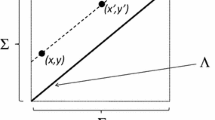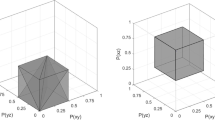Abstract
We present new axiomatisations for various models of binary stochastic choice that may be characterised as “expected utility maximisation with noise”. These include axiomatisations of simple scalability (Tversky and Russo in J Math Psychol 6:1–12, 1969) with respect to a scale having the expected utility (EU) form, and strong utility (Debreu in Econometrica 26(3):440–444, 1958) of the EU form. The latter model features Fechnerian “noise”: choice probabilities depend on EU differences. Our axiomatisations complement the important contributions of Blavatskyy (J Math Econ 44:1049–1056, 2008) and Dagsvik (Math Soc Sci 55:341–370, 2008). Our representation theorems set all models on a common axiomatic foundation, with additional axioms added in modular fashion to characterise successively more restrictive models. The key is a decomposition of Blavatskyy’s (2008) common consequence independence axiom into two parts: one (which we call weak independence) that underwrites the EU form of utility and another (stochastic symmetry) than underwrites the Fechnerian structure of noise. We also show that in many cases of interest (which we call preference-bounded domains) stochastic symmetry can be replaced with weak transparent dominance (WTD). For choice between lotteries, WTD only restricts behaviour when choosing between probability mixtures of a “best” and a “worst” possible outcome.
Similar content being viewed by others
References
Bhatia, S., Loomes, G.: Noisy preferences in risky choice: a cautionary note. Psychol. Rev. 124(5), 678–687 (2017)
Birnbaum, M.H., Navarrete, J.B.: Testing descriptive utility theories: violations of stochastic dominance and cumulative independence. J. Risk Uncertain. 17(1), 49–79 (1998)
Blavatskyy, P.R.: Stochastic utility theorem. J. Math. Econ. 44, 1049–1056 (2008)
Blavatskyy, P.R.: A model of probabilistic choice satisfying first-order stochastic dominance. Manag. Sci. 57(3), 542–548 (2011)
Blavatskyy, P.R.: Probabilistic choice and stochastic dominance. Econ. Theor. 50(1), 59–83 (2012)
Blavatskyy, P.: Fechner’s strong utility model for choice among \( n>2\) alternatives: risky lotteries, Savage acts, and intertemporal payoffs. J. Math. Econ. 79, 75–82 (2018)
Blavatskyy, P.R., Pogrebna, G.: Models of stochastic choice and decision theories: why both are important for analyzing decisions. J. Appl. Econom. 25(6), 963–986 (2010)
Block, H.D., Marschak, J.: Random orderings and stochastic theories of response. In: Olkin, I., Ghurye, S., Hoeffding, W., Madow, W., Mann, H. (eds.) Contributions to Probability and Statistics I. Stanford University Press, Stanford (1960)
Dagsvik, J.K.: Axiomatization of stochastic models for choice under uncertainty. Math. Soc. Sci. 55, 341–370 (2008)
Dagsvik, J.K.: Stochastic models for risky choices: a comparison of different axiomatizations. J. Math. Econ. 60, 81–88 (2015)
Davidson, D., Marschak, J.: Experimental tests of a stochastic decision theory. In: Churchman, C.W., Ratoosh, P. (eds.) Measurement: Definitions and Theories. Wiley, New York (1959)
Debreu, G.: Stochastic choice and cardinal utility. Econometrica 26(3), 440–444 (1958)
Fishburn, P.C.: Binary choice probabilities: on the varieties of stochastic transitivity. J. Math. Psychol. 10(4), 327–352 (1973)
Fishburn, P.C.: The Foundations of Expected Utility. D. Reidel Publishing, Dordrecht
Fishburn, P.C.: SSB utility theory: an economic perspective. Math. Soc. Sci. 8(1), 63–94 (1984)
Gul, F., Pesendorfer, W.: Random expected utility. Econometrica 74(1), 121–146 (2006)
Herstein, I.N., Milnor, J.: An axiomatic approach to measurable utility. Econometrica 21(2), 291–297 (1953)
Köbberling, V.: Strength of preference and cardinal utility. Econ. Theor. 27(2), 375–391 (2006)
Krantz, D.H.: The Scaling of Small and Large Color Differences. Ph.D. thesis, University of Pennsylvania (1964)
Luce, R.D.: Individual Choice Behavior: A Theoretical Analysis. Wiley, New York (1959)
Luce, R.D., Suppes, P.: Preference, utility and subjective probability. In: Luce, R.D., Bush, R.B., Galanter, E. (eds.) Handbook of Mathematical Psychology, vol. III. Wiley, New York (1965)
Marschak, J.: Binary choice constraints and random utility indicators. In: Arrow, K.J., Karlin, S., Suppes, P. (eds.) Mathematical Methods in the Social Sciences. Stanford University Press, Stanford (1960)
Roberts, F.S.: Homogeneous families of semiorders and the theory of probabilistic consistency. J. Math. Psychol. 8(2), 248–263 (1971)
Ryan, M.J.: Mixture sets on finite domains. Decisions Econ. Finan. 33(2), 139–147 (2010)
Ryan, M.J.: A strict stochastic utility theorem. Econ. Bull. 35(4), 2664–2672 (2015)
Ryan, M.J.: Binary choices that satisfy stochastic betweenness. J. Math. Econ. 70, 176–184 (2017)
Ryan, M.J.: Uncertainty and binary stochastic choice. Econ. Theor. 65(3), 629–662 (2018a)
Ryan, M.J.: Strict scalability of choice probabilities. J. Math. Psychol. 18, 89–99 (2018b)
Stott, H.P.: Cumulative prospect theory’s functional menagerie. J. Risk Uncertain. 32(2), 101–130 (2006)
Suppes, P., Krantz, D.H., Luce, R.D., Tversky, A.: Foundations of Measurement, vol. II. Academic Press, San Diego (1989)
Tversky, A.: Elimination by aspects: a theory of choice. Psychol. Rev. 79(4), 281–299 (1972a)
Tversky, A.: Choice by elimination. J. Math. Psychol. 9, 341–367 (1972b)
Tversky, A., Russo, J.E.: Substitutability and similarity in binary choices. J. Math. Psychol. 6, 1–12 (1969)
Acknowledgements
My thanks to Aurélien Baillon and two anonymous referees for numerous suggestions which have materially improved the paper. I have also benefitted from the comments of audiences at the University of Queensland, Queen Mary University of London, the 37th Australasian Economic Theory Workshop (University of Technology Sydney) and the DECIDE Workshop on Experimental Economics (University of Auckland).
Author information
Authors and Affiliations
Corresponding author
Additional information
Publisher's Note
Springer Nature remains neutral with regard to jurisdictional claims in published maps and institutional affiliations.
Previous drafts have circulated under the title“Stochastic Expected Utility for Binary Choice: New Representations”.
Rights and permissions
About this article
Cite this article
Ryan, M. Stochastic expected utility for binary choice: a ‘modular’ axiomatic foundation. Econ Theory 72, 641–669 (2021). https://doi.org/10.1007/s00199-020-01307-8
Received:
Accepted:
Published:
Issue Date:
DOI: https://doi.org/10.1007/s00199-020-01307-8




